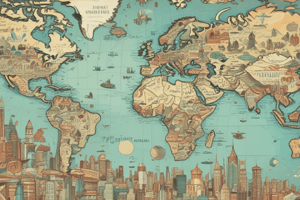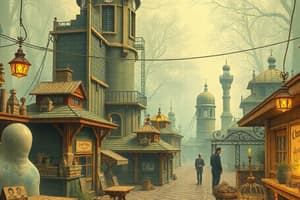Podcast
Questions and Answers
Define scarcity.
Define scarcity.
When there are not enough resources to meet human wants.
Why does scarcity force choice-making?
Why does scarcity force choice-making?
People have to choose their wants.
What are the four factors of production?
What are the four factors of production?
Land, Labor, Capital, Entrepreneurship.
What is the factor of production: Land?
What is the factor of production: Land?
What is the factor of production: Labor?
What is the factor of production: Labor?
What is the factor of production: Capital?
What is the factor of production: Capital?
What is the factor of production: Entrepreneurship?
What is the factor of production: Entrepreneurship?
Define opportunity cost.
Define opportunity cost.
Define trade-offs.
Define trade-offs.
What is the difference between trade-offs and opportunity cost?
What is the difference between trade-offs and opportunity cost?
What does a production possibilities curve represent?
What does a production possibilities curve represent?
Define efficiency.
Define efficiency.
Define underutilization.
Define underutilization.
Flashcards are hidden until you start studying
Study Notes
Scarcity
- Defined as the situation where resources are insufficient to satisfy human desires.
- Requires individuals and societies to prioritize their wants.
Choice-Making
- Scarcity necessitates decision-making as people must select among competing wants.
Factors of Production
- Four main factors: Land, Labor, Capital, and Entrepreneurship.
Land
- Refers to natural resources utilized in producing goods and services.
- Examples include forests, minerals, and water.
Labor
- Encompasses all human efforts, skills, and time involved in production.
- Includes any invested work by employees and workers.
Capital
- Represents physical resources that contribute to the production of goods and services.
- Examples are equipment like ovens and cash registers.
Entrepreneurship
- Involves individuals who take risks to innovate and drive production.
- Key figures include business leaders such as CEOs and business owners.
Opportunity Cost
- Defined as the value of the next best alternative that is forgone in making a decision.
- Highlights the trade-off between different choices.
Trade-Offs
- Refers to the alternatives that individuals give up when making decisions.
- Involves sacrificing some resources or benefits to gain others, not an all-or-nothing scenario.
Difference Between Trade-Offs and Opportunity Cost
- Trade-offs refer to the alternatives that are passed over, while opportunity cost measures the value lost from the next best option.
Production Possibilities Curve (PPC)
- Visual representation of production efficiency and potential.
- Point A indicates efficiency in resource utilization.
- Point B illustrates production limits under current resources.
- Point C shows underutilization of resources where they are not employed to full potential.
Efficiency
- Describes a scenario where resources are fully and effectively utilized to maximize outputs of goods and services.
Underutilization
- Indicates a state where economic resources are not being employed to their maximum potential, resulting in lost opportunities.
Studying That Suits You
Use AI to generate personalized quizzes and flashcards to suit your learning preferences.




